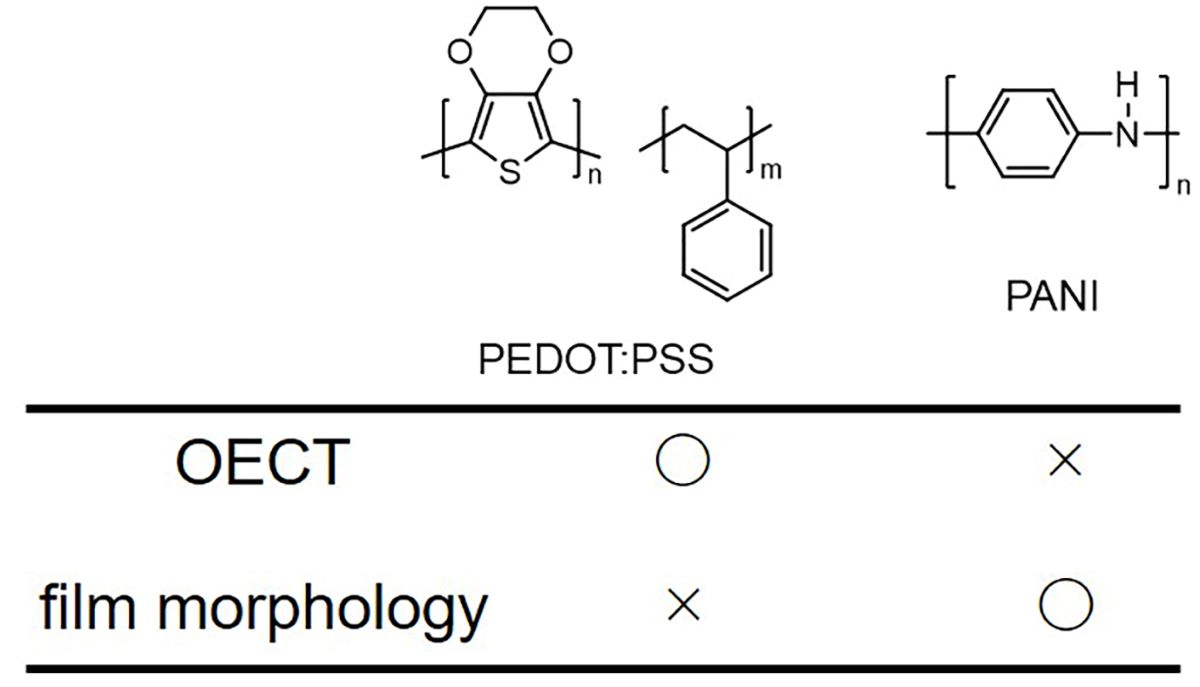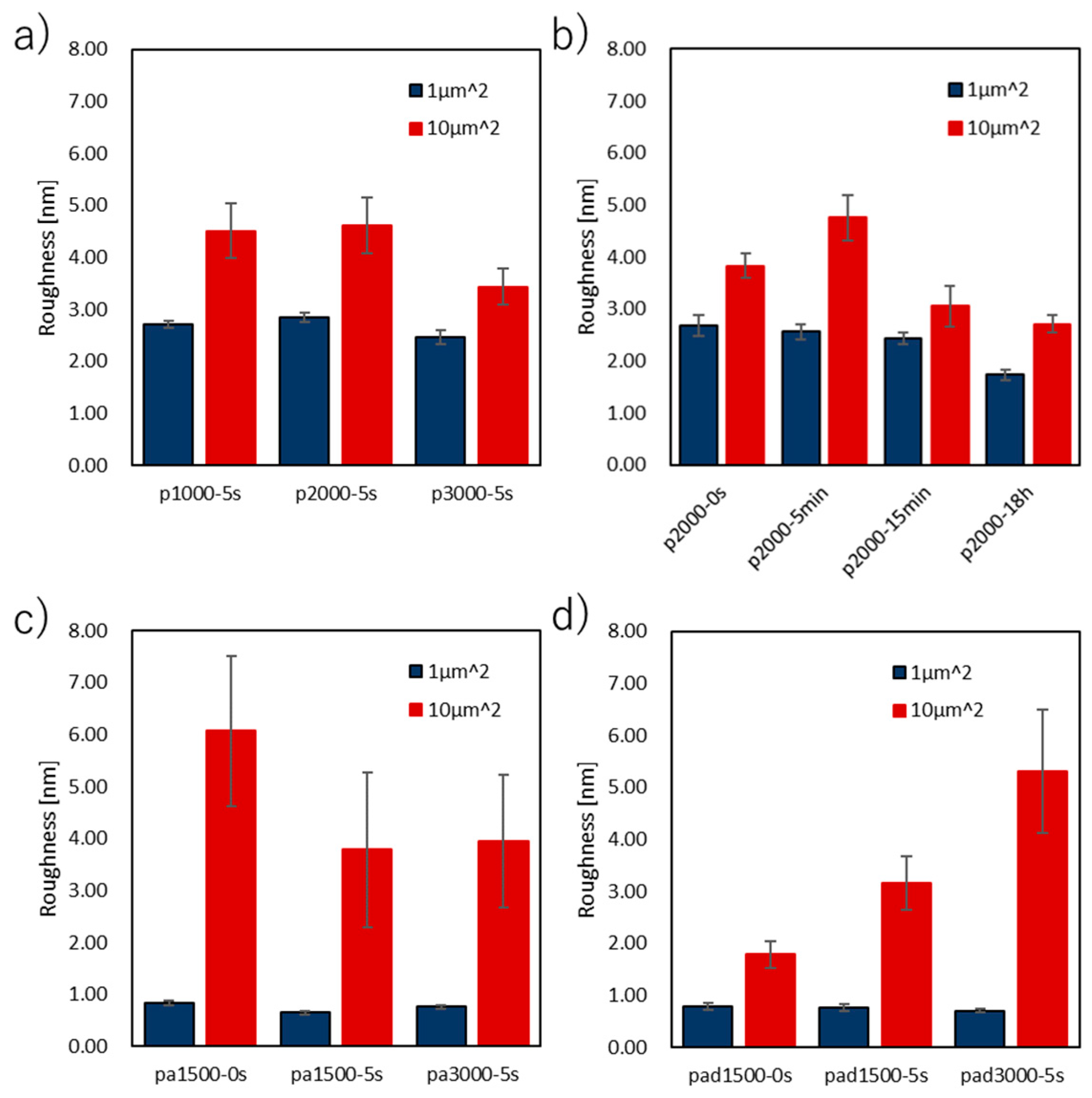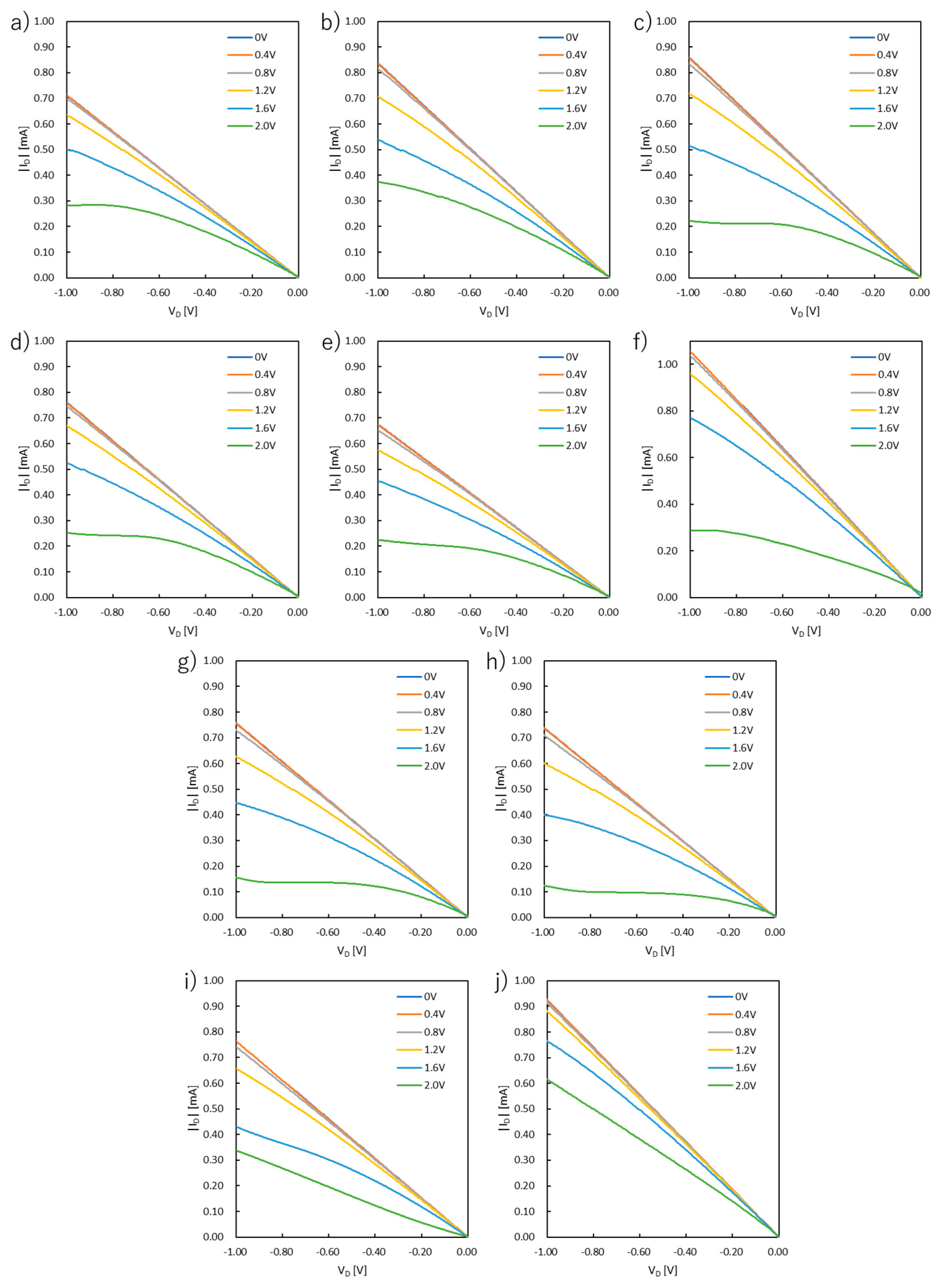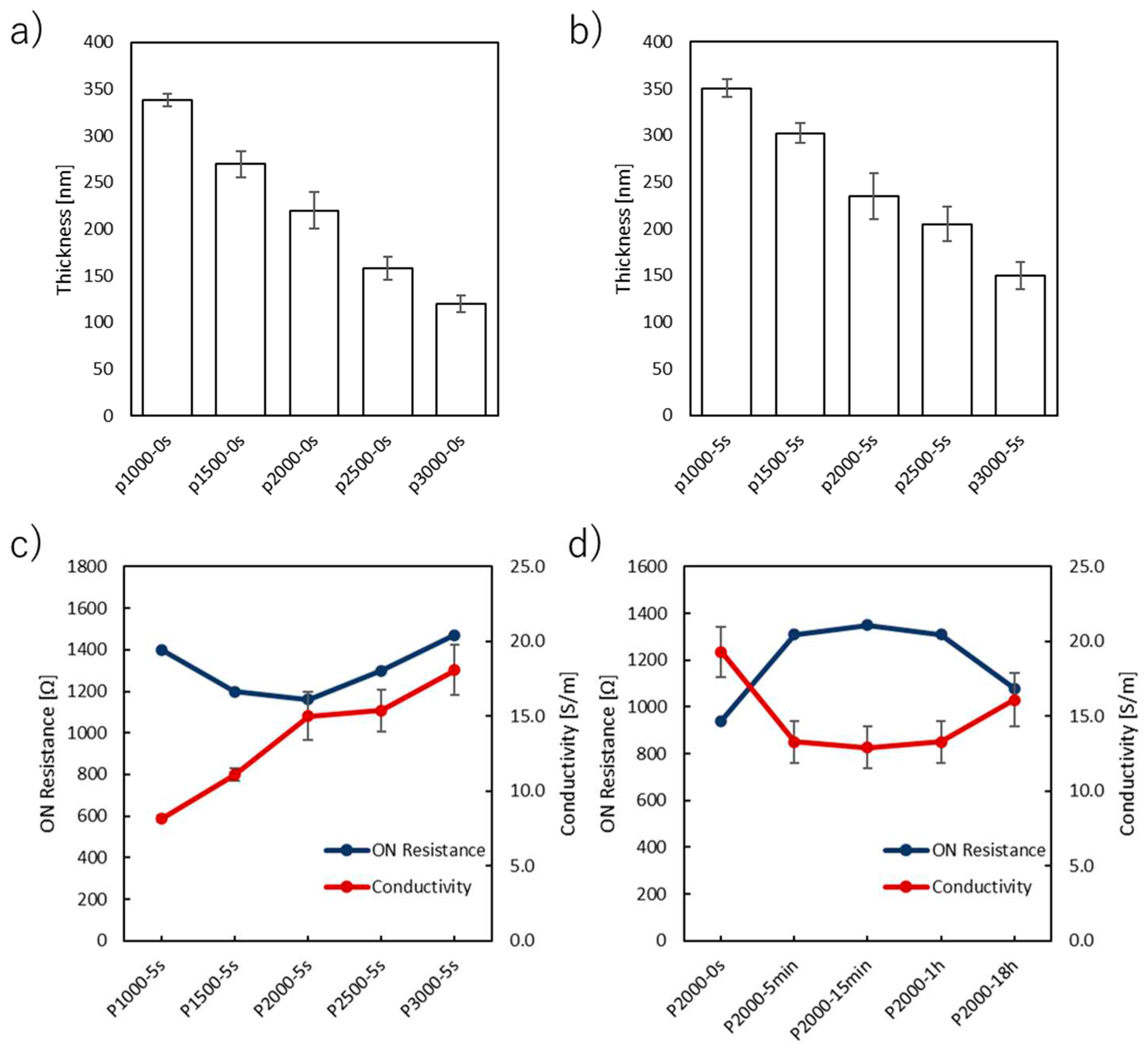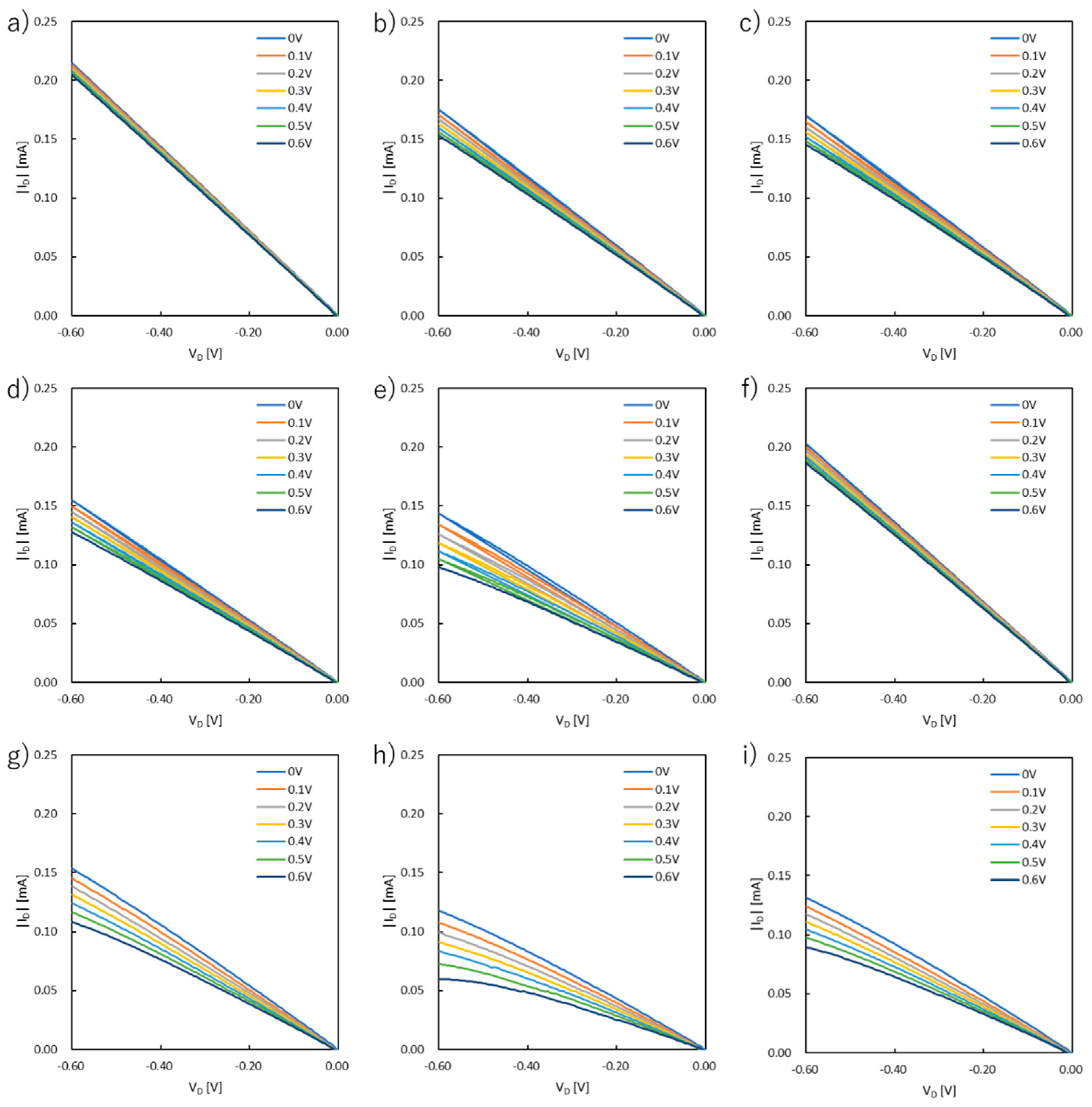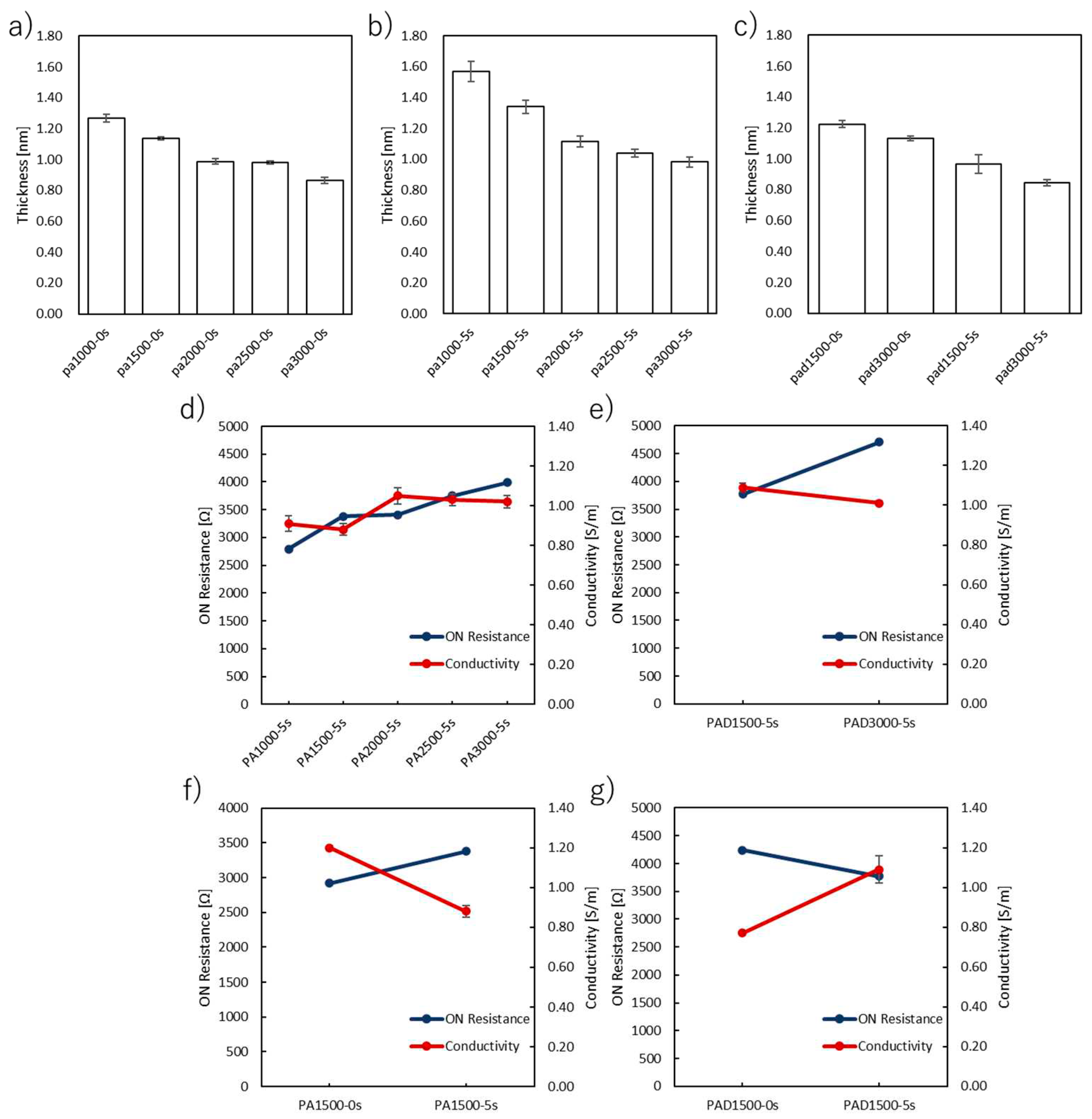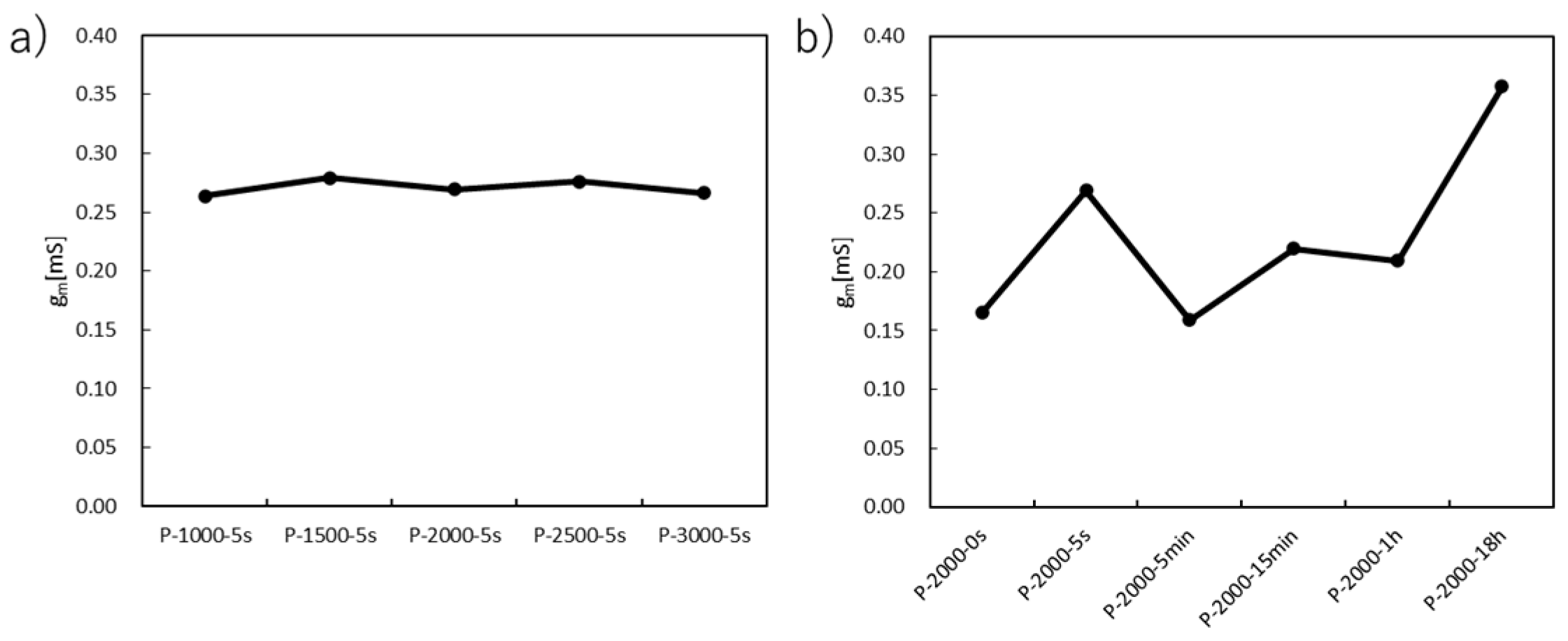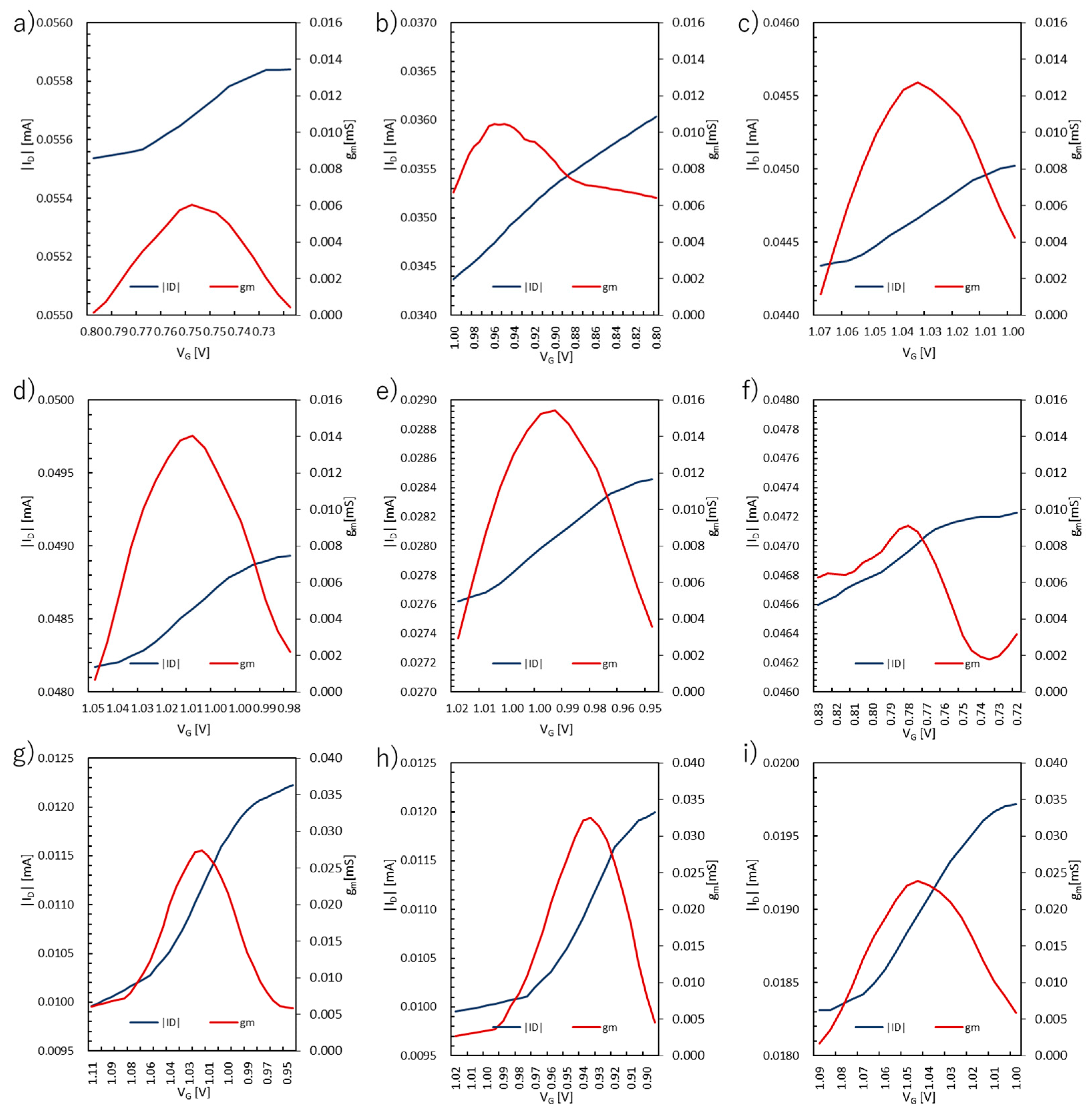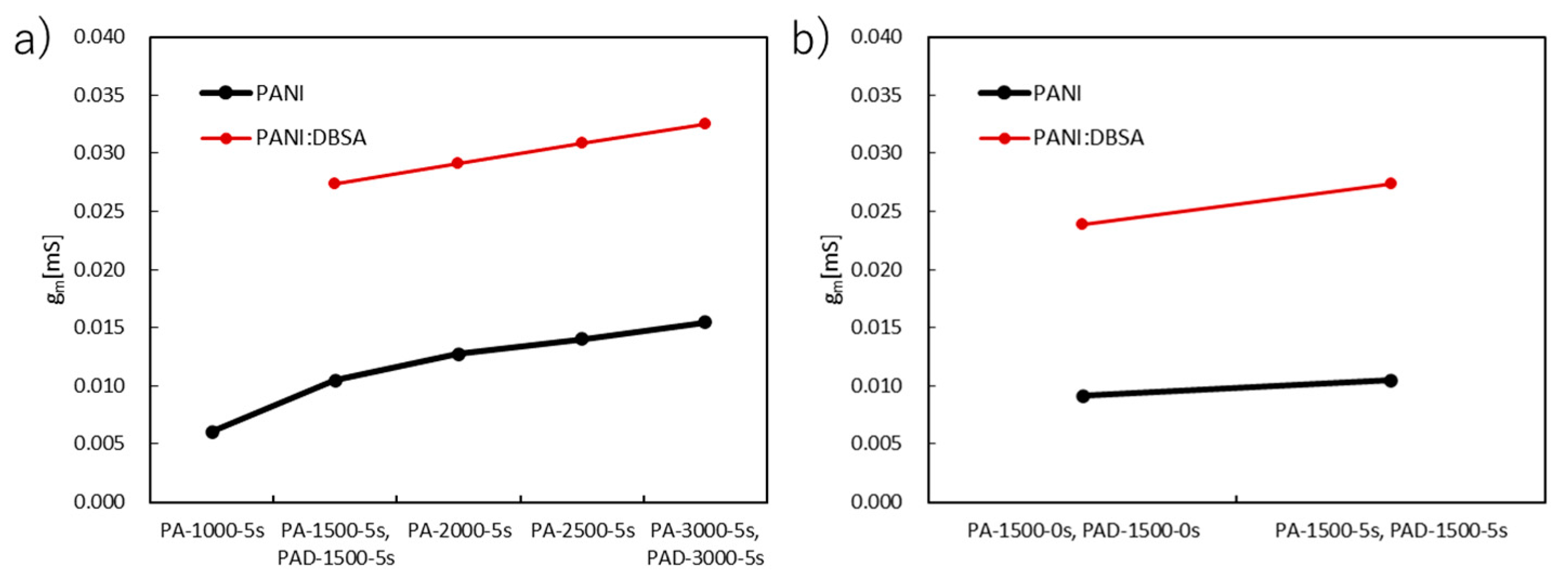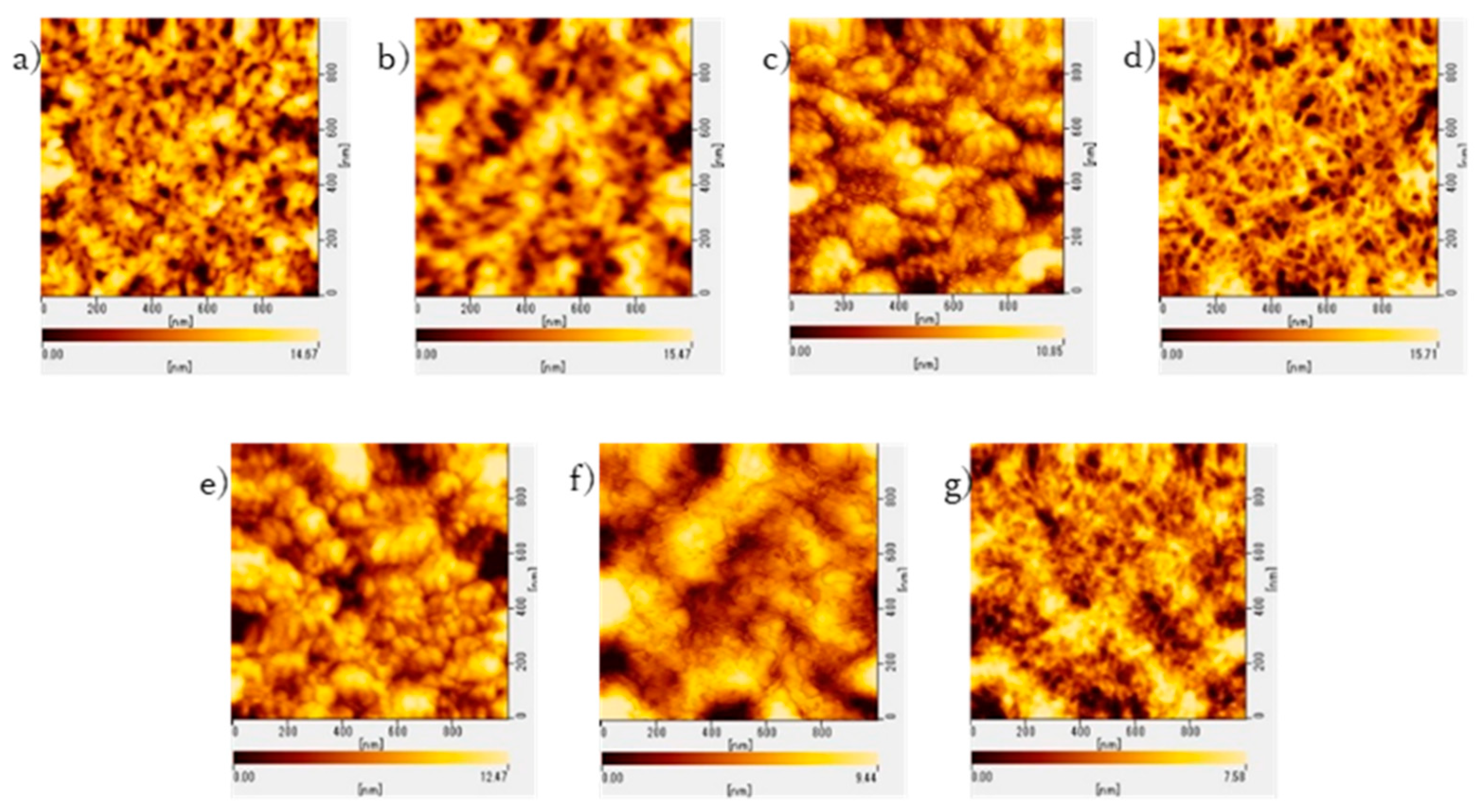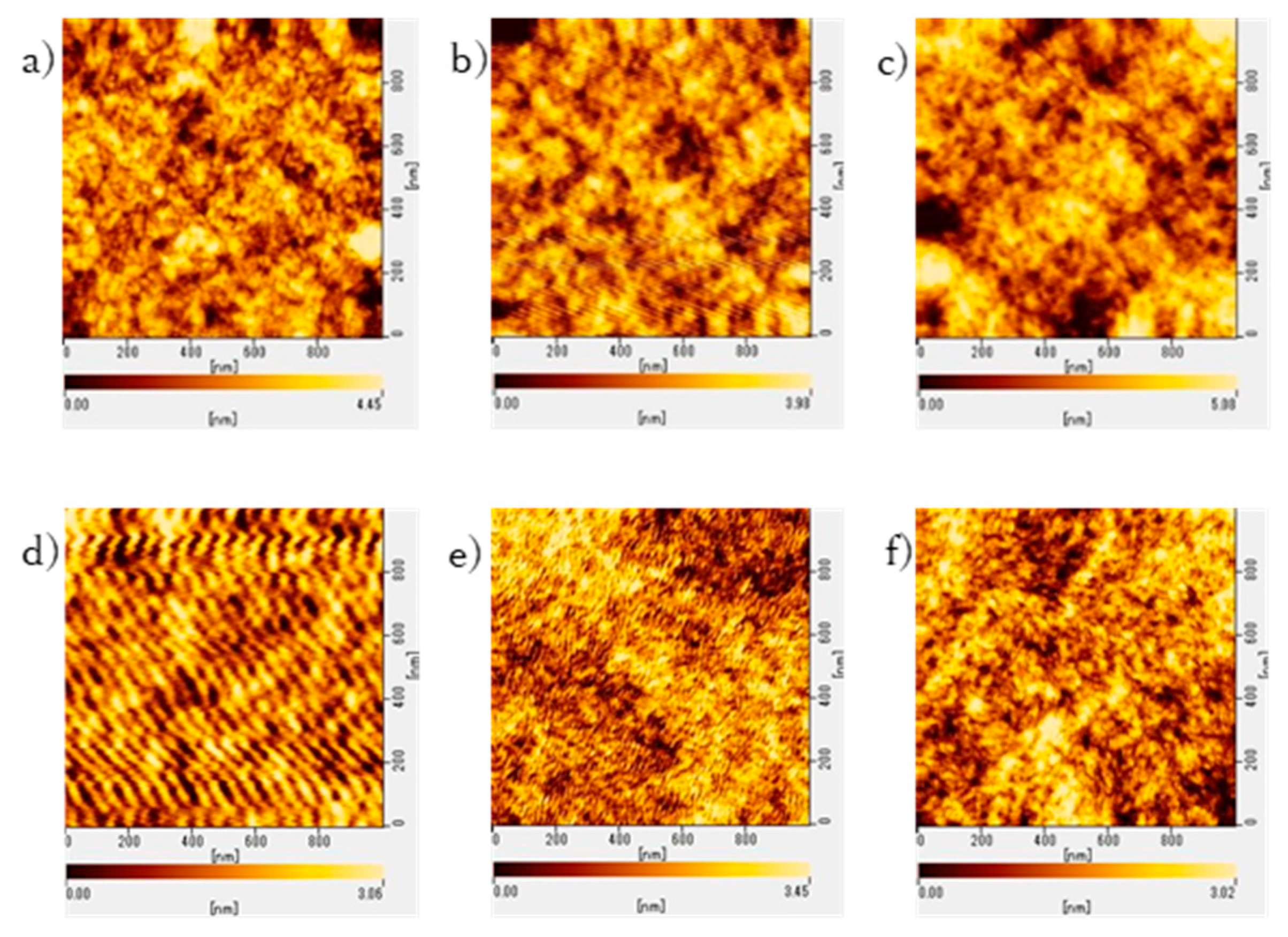1. Introduction
Conducting polymers are expected to find applications in various industrial fields because of their light weight, low cost, and flexibility [
1]. They become conductive by either chemical or electrochemical doping, which injects charge carriers into polymers [
2]. Doping allows the conductivity of polymers to be freely controlled, as well as other physical properties.
Poly(3,4-ethylenedioxythiophene) polystyrene sulfonate (PEDOT:PSS) is one of the most studied conducting polymers, and its applications in sensing and other technologies, such as pH sensors [
3], glucose sensors [
4], and enzyme sensors [
5], are in practical use [
6].
PEDOT:PSS is usually dispersed as colloids in an aqueous solution, and the thin films can be prepared by solution casting. It is known that the conductivity of PEDOT:PSS increases by nearly two orders of magnitude by adding specific solvents, such as ethylene glycol, dimethyl sulfoxide, and sorbitol [
7]. When OECT applications are considered, PEDOT:PSS films must be crosslinked because OECTs operate with aqueous electrolytes. Therefore, effective cross-linkers, such as (3-glycidyloxypropyl)trimethoxysilane (GOPS), are used to make them insoluble in aqueous solutions [
8].
In addition to PEDOT:PSS, polyaniline (PANI) is a typical example of a conducting polymer. One of the main characteristics of PANI is that the raw material, aniline, is relatively inexpensive and oxidative polymerization is easy. Furthermore, it is known that the solubility in organic solvents can be improved by using dopants, such as 10-camphorsulfonic acid (CSA) and dodecylbenzenesulfonic acid (DBSA) [
2]. Therefore, in recent years, PANI is expected to be applied to the field of sensing [
9]. On the other hand, it has been pointed out that the conductivity of PANI is inferior to PEDOT:PSS. Therefore, the use of PANI in the development of biosensors with good sensitivity and accuracy remains a challenge.
There are many examples of OECTs based on conducting polymers [
10,
11,
12,
13,
14,
15,
16,
17,
18,
19]. However, further research is needed to improve their performance for use in high-performance biosensors and related technologies. In this study, OECTs based on two well-known conducting polymers, PEDOT:PSS and PANI, were fabricated and their device performances and durability were optimized. By comparing the two types of conducting polymers, we aim to discuss more optimal conditions for OECTs using conducting polymers and especially the applicability of PANI-based OECTs, because there are few precedents [
20,
21].
2. Materials and Methods
PEDOT:PSS (0.5-1wt% dispersion in water) was purchased from Sigma-Aldrich. Polyaniline (PANI) was kindly supplied from the Idemitsu Co. Ethylene glycol was purchased from Kanto Chemicals Co. (3-Glycidyloxypropyl)trimethoxysilane (GOPS) and dodecylbenzene sulfonic acid (DBSA) were purchased from TCI. These chemicals were used to blend the PEDOT:PSS or PANI solution. For the preparation, 150 μL (3%) of ethylene glycol, 12 μL (about 0.25%) of DBSA, and 50 μL (1%) of GOPS were mixed with 5 mL of the commercial PEDOT:PSS solution. First, ethylene glycol and DBSA were added to PEDOT:PSS and stirred for 10 minutes with sonication. Then, 50 μL (1%) of GOPS was added and stirred for 1 minute while being sonicated again. For PANI:DBSA, about 12μL of DBSA was mixed with 5 mL of PANI and stirred with sonication.
The fabrication of OECTs was done with care to avoid contamination with impurities. First, the surface of the electrode substrate was cleaned with DI water and made hydrophilic by irradiating it with ozone plasma for 20 minutes. The commercial PEDOT:PSS solution was spin-coated onto the surface-modified electrode. First, the rotation speed was set to 4000 rpm, and DI water was dropped and rotated for 30 seconds to briefly clean the surface. After that, 75 μL of the PEDOT:PSS solution was dropped and held without rotation for 100 seconds. Spin coating was then performed at a constant rotation speed (1000-3000 rpm) for 40 seconds. After spin-coating was completed, it was annealed at 135 °C for 1 hour to form a PEDOT:PSS film on the electrode. The electrode was immersed in DI water (0~18 h) to remove impurities such as low molecular weight PEDOT and form the smooth film surface. Coatings in unnecessary areas were removed by blowing water off the surface. The prepared samples are summarized
Table 1. In the case of PANI and PANI:DBSA, ozone plasma irradiation was not performed and chloroform was used to clean the electrodes instead of DI water. Other than these points, the same procedure was used for spin-coating, followed by annealing at 135 °C for 30 minutes. Immersing in DI water was performed only for 0 s and 5 s. The prepared samples are summarized in
Table 2.
In the OECT measurements, conductivity and transconductance values were calculated from the output and transfer characteristics. The electrodes used were L = 10 μm and W = 2500 μm. In the measurements of output characteristics, conductivities were calculated from the portion of the linear region with a gate voltage of 0 V. The measurement conditions were set for VD from 0 V to 1.5 V and for VG from 0 V to 2.0 V at 0.4 V intervals. For the measurement conditions of the transfer characteristics of the PEDOT:PSS device, VG was set from 2.2 V to -1.0 V and VD was fixed at -0.6 V. The transconductance that reached its peak due to the sudden change in drain current was replaced by the value before or after the peak.
3. Results
3.1. Output characteristics
The output curves of PEDOT:PSS devices and PANI devices are shown in
Figure 1 and
Figure 3, respectively. In the case of PANI devices, the V
D was set in the range of 0 V to 0.6 V and the V
G was measured from 0 V to 0.6 V at intervals of 0.1 V. The values of on-resistance, resistivity, and conductivity were estimated from the OECT performances and are summarized in
Figure 2 and
Figure 4 and
Tables S1 and S2.
The output characteristics of the PEDOT:PSS-based devices were optimized by changing the spin-coating rate. The results revealed that the resistance was higher than 1400 Ω when PEDOT:PSS films were prepared at the spin-coating rate of 1000 rpm and rinse time in DI water of 5 s (P1000-5s). This was also the case for the spin-coating rate of 3000 rpm (P3000-5s). However, when the spin-coating rate was 2000 rpm (P2000-5s), the lowest resistance value was obtained. On the other hand, the device (P3000-5s) showed the highest conductivity of 18.1 S m
-1. Conductivity increased with the increasing spin-coating rate, which is most likely associated with the film thickness and morphology. There is a previous study that PEDOT:PSS films crystallize when they are thermally annealed [
10]. This implies that, the thicker the film, the less uniform the crystallized PEDOT, and the thicker the films prepared at low spin-coating rates, the lower the conductivity. Overall, the film thickness is one of the significant parameters to optimize the electrical properties. Thinning the film thickness improves the calculated conductivity, but may increase resistance due to the decrease in channel area. Therefore, a film thickness of about 150 nm is considered optimal.
The as-cast films were immersed in DI water to obtain the optimized surface morphology. The immersion time in DI water was thus one of the parameters to achieve high-performance OECTs. The device based on the as-cast film (P2000-0s) gave the lowest resistance and highest conductivity. The conductivity decreased from P2000-0s to P2000-15min, but slightly increased when the immersion time was prolonged to 1 h (P2000-1h). The conductivity of the device (P2000-18h) was comparable to that of P2000-5s. The purpose of immersing the films in DI water was to obtain a better film surface by partially dissolving oligomers and impurities. However, the conductivity of the device (P2000-5s) was indeed lower than that of P2000-0s. This result suggested that the as-cast film is sufficient for OECT applications.
The output characteristics of the PANI-based OECTs showed efficient conductivities, although the devices prepared at the larger spin-coating rates had higher on-resistance. The disadvantage of a thinner film is that the channel bandwidth to be stored is considerably narrower, resulting in a lower conductivity. This effect also reduces the durability against potential difference loading between the source and drain electrodes. Specifically, the drain voltage could be applied up to about 1 V for PA1000-5s. However, in the PA3000-5s, the operation became unstable at around 0.6 V, and the drain current sharply dropped. For the film thickness, considering this issue, 3000 rpm is the upper limit of the spin-coating rate under the measurement conditions.
The immersion in DI water resulted in a decrease in the conductivity even after about 5 seconds of immersion. As for the film thickness, the surface was somewhat scraped by immersion, resulting in a thin film. However, the conductivities of the devices prepared at the high spin-coating rates were large, suggesting oxidation of the films. Therefore, this immersion operation in water was found to be unsuitable for PANI.
Similar to PANI, the conductivities of the PANI:DBSA devices with higher spin-coating rates were higher. When PAD1500-5s with DBSA was compared with PA1500-5s without DBSA, PAD1500-5s had higher on-resistance and thinner films. In addition, the conductivity was slightly improved by increasing the spin-coating rate. When PAD3000-5s and PA3000-5s were compared, the conductivity was similar. Comparing PAD1500-0s and PA1500-0s, the conductivity of PAD1500-0s was considerably lower. Since it was reported that the addition of DBSA to PANI decreases conducting and other related properties, the conductivity of PANI:DBSA without DI water washing was lower than that of the corresponding PANI film [
22]. However, since the addition of DBSA most likely improved water resistance and chemical endurance, the conductivity increased when washed with DI water. This is because the negative impact of DI water immersion is considerably smaller than that of the PANI film.
3.2. Transfer characteristics
The transfer curves and transconductance of the PEDOT:PSS devices are shown in
Figure 5 and
Figure 6, respectively. The highest transconductance of 0.280 mS was obtained for P1500-5s when the spin-coating rate was optimized. The next highest value was 0.276 mS for P2500-5s, and the other three types had the maximum transconductance in the range of 0.260~0.270 mS. The error from the average value of the maximum transconductance was within ±0.01 mS, indicating that the maximum transconductance hardly changes as the film thickness changes.
On the other hand, the immersion time in DI water showed a different behavior. The maximum transconductance increased with immersion time short enough to momentarily wash the surface and decreased with longer immersion time. The maximum value gradually increased with continued immersion for a longer period. Two sets of data, P2000-0s and P2000-5min, showed maximum values well below 0.20 mS. Therefore, it is likely that the transconductance is affected by the surface condition of the film due to the immersion in DI water.
For PANI, the V
G was set from 1.5 V to 0 V, and the V
D was fixed at -0.2 V. The transfer curves and transconductance of the PANI devices are shown in
Figure 7 and
Figure 8, respectively. In the case of PANI, the maximum transconductance increased with increasing spin-coating rates, with PA3000-5s having the highest value of 0.0154 mS. This may be because of the improved surface morphology of the film. However, as the spin-coating rate increased, the gate voltage durability of the PANI film caused an issue. The highest applied voltage durability was 2.0 V for PA1000-5s, which tended to gradually decrease as the film became thinner. Samples of PANI films were prepared at spin-coating rates of 3500 and 4000 rpm, and measurements were attempted under the same conditions. However, the attempted measurement conditions did not provide data from which the transconductance could be calculated. This trend was also true for PANI:DBSA, with PAD3000-5s being higher than PAD1500-5s, at 0.0325 mS. Furthermore, when compared with and without the addition of DBSA, the maximum transconductance more than doubled with the addition of DBSA. Similar to the PANI film, we prepared the PANI:DBSA film at 4000 rpm, but the transconductance could not be calculated.
When the PANI films were immersed in DI water, the transconductance values were higher than those of the films that were not immersed. The surface morphology of the film is thought to have a significant impact. PANI:DBSA films also improved the maximum transconductance by a factor of 2 or more.
3.3. Surface morphology
The surface morphology of the spin-coated films was observed by atomic force microscopy (AFM). Samples were prepared by spin-coating the polymer solutions on a glass substrate using the same procedure as for an electrode substrate, and the center area of the glass substrate was observed. The PEDOT:PSS samples observed were P1000-5s, P2000-5s, P3000-5s, P2000-0s, P2000-5min, P2000-15min, and P2000-18h. The images in the range of 1μm
2 are shown in
Figure 9. The surface roughness of the samples is shown in
Figure 11 and summarized in
Table S3.
The surface morphology of P2000-5s was rougher than that of P1000-5s. In comparison, P3000-5s had a slightly smoother surface. When the films were not immersed in DI water, the film surfaces were slightly smoother than those immersed shortly. Thus, immersion in DI water for short periods of time may slightly degrade the film surface. However, the longer the immersion time in DI water, the smoother the surface became. As a consequence, P2000-18h had the smoothest surface.
The surface morphology of the PANI films was also observed using AFM. The samples observed were PA1500-5s, PA3000-5s, PA1500-0s, PAD1500-5s, PAD3000-5s, and PAD1500-0s. Images in the 1μm
2 range are shown in
Figure 10. The surface roughness of the samples is shown in
Figure 11 and summarized in
Table S4.
Regarding the surface morphology of the PANI films, the surface roughness of both 1μm2 and 10μm2 became smoother by increasing the spin-coating rate. When immersed in DI water, the surface roughness decreased by nearly 0.2 nm, indicating that the surface became smoother. In PANI:DBSA, comparing PAD1500-5s and PAD3000-5s, the surface roughness at 10μm2 was smoother on PAD1500-5s. However, PAD-3000-5s was smoother at 1μm2. The sample without DI water rinse had a slightly rougher surface at 1μm2, but much smoother results in the 10 μm2 range. This may be due to the possibility that the samples with DBSA were more prone to mottling of the surface morphology due to washing.
Figure 11.
Surface roughness (Ra) of the PEDOT:PSS films at (a) various spin-coating rates and (b) various immersion times in DI water and the PANI and PANI:DBSA films at (c) various spin-coating rates and (b) various immersion times in DI water.
Figure 11.
Surface roughness (Ra) of the PEDOT:PSS films at (a) various spin-coating rates and (b) various immersion times in DI water and the PANI and PANI:DBSA films at (c) various spin-coating rates and (b) various immersion times in DI water.
4. Discussion
From the above results, the best OECT performance for PEDOT:PSS was obtained at a spin-coating rate of 2000 rpm and immersion in DI water for 18 hours. For PANI, the best performance was obtained by adding DBSA, spin-coating at 3000 rpm, and washing the surface with DI water for a short time of about 5 seconds.
On-resistance and conductivity were higher for PEDOT:PSS, and conductivity was about 16 times higher than that of PANI, partly due to its thinner film. The maximum transconductance was 13 times higher for PEDOT:PSS. These results indicate that PEDOT:PSS considerably outperforms PANI in terms of performance as an OECT. This is thought to be because the presence of PSS considerably improved the oxidation resistance of the PEDOT:PSS film, allowing the formation of a relatively wide flow path even when the films are thin.
However, the uniformity of film thickness and the smoothness of the film surface are superior for PANI. In terms of film thickness, PEDOT:PSS showed a large difference in thickness depending on the location, whereas PANI showed a fairly uniform film thickness at 1μm2. Considering that PEDOT:PSS required various preparations to fabricate OECTs, PANI is superior in that better morphology films can be easily formed in a shorter time. The surface of the PANI film was relatively easy to scrape, resulting in a large surface roughness value at 10μm2. In this regard, further surface smoothness and performance improvement can be expected by establishing a uniform cleaning method with DI water.
5. Conclusions
In this study, OECTs were fabricated using PEDOT:PSS and PANI, and their performances were evaluated. Regarding the optimization of fabrication conditions, in the case of PEDOT:PSS, a polymer film with a thickness of 150 nm was obtained by spin-coating at 3000 rpm and immersion in DI water for 18 hours, based on the uniformity inside the film and the smoothness of the surface.
For PANI, the OECT performances and film surface morphology studies revealed that doping with DBSA improves the carrier concentration. Based on the effect of film surface smoothness, it was also found that the optimal conditions for PANI doped with DBSA were a spin-coating rate of 3000 rpm and surface washing with DI water for about 5 seconds, resulting in a polymer film with a thickness of 0.84 μm. The conductivity and maximum transconductance tended to increase with the increasing spin-coating rate, and further improvement in values may be expected by increasing the spin-coating rate higher than 3000 rpm. However, the higher oxidation rate and the shrinkage of channels formed by thinning and the associated decrease in current and voltage tolerance had a greater impact, resulting in less stable OECT and less reliable data.
The basic performance of the PEDOT:PSS-based OECT is higher than that of the PANI-based OECT, and this is the reason why there are many PEDOT:PSS-based OECT studies. On the other hand, PANI is superior in terms of the smoothness of the polymer film, and research on biosensors using the PANI-based OECT is expected in the future.
Supplementary Materials
The following supporting information can be downloaded at:
www.mdpi.com/xxx/s1, Table S1: OECT characteristics based on PEDOT:PSS; Table S2: OECT characteristics based on PANI; Table S3: Surface roughness data of PEDOT:PSS films; Table S4: Surface roughness data of PANI films.
Author Contributions
Conceptualization, T.M.; investigation, R.K.; writing—original draft preparation, R.K.; writing—review and editing, T.M.; funding acquisition, T.M. All authors have read and agreed to the published version of the manuscript.
Data Availability Statement
The data presented in this study are available on request from the corresponding author.
Acknowledgments
This study was partially supported by the Amano Institute of Technology.
Conflicts of Interest
The authors declare no conflict of interest.
References
- Naveen, M. H; Gurudatt, N, G: Shim, Y.-B. Applications of conducting polymer composites to electrochemical sensors: A review. Appl. Mater. Today 2017, 9, 419–433. [Google Scholar] [CrossRef]
- Kimpel, J.; Michinobu, T. Conjugated Polymers for Functional Applications: Lifetime and Performance of Polymeric Organic Semiconductors in OFETs. Polym. Int. 2021, 70, 367–373. [Google Scholar] [CrossRef]
- Scheiblin, G.; Coppard, R.; Owens, R. M.; Mailley, P.; Malliaras, G. G. Referenceless pH Sensor using Organic Electrochemical Transistors. Adv. Mater. Technol. 2017, 2, 1600141. [Google Scholar] [CrossRef]
- Tang, H.; Yan, F.; Lin, P.; Xu, J.; Chan, H. L. W. Highly Sensitive Glucose Biosensors Based on Organic Electrochemical Transistors Using Platinum Gate Electrodes Modified with Enzyme and Nanomaterials. Adv. Funct. Mater. 2011, 21, 2264–2272. [Google Scholar] [CrossRef]
- Wustoni, S.; Savva, A.; Sun, R.; Bihar, E.; Inal, S. Enzyme-Free Detection of Glucose with a Hybrid Conductive Gel Electrode. Adv. Mater. Interfaces 2019, 6, 1800928. [Google Scholar] [CrossRef]
- Kenry; Yeo, J. C.; Lim, C. T. Emerging flexible and wearable physical sensing platforms for healthcare and biomedical applications. Microsyst. Nanoeng. 2016, 2, 16043. [Google Scholar] [CrossRef] [PubMed]
- Ouyang, J.; Chu, C.-W.; Chen, F.-C.; Xu, Q.; Yang, Y. High-Conductivity Poly(3,4-ethylenedioxythiophene):Poly(styrene sulfonate) Film and Its Application in Polymer Optoelectronic Devices. Adv. Funct. Mater. 2005, 15, 203–208. [Google Scholar] [CrossRef]
- ElMahmoudy, M.; Inal, S.; Charrier, A.; Uguz, I.; Malliaras, G. G. Tailoring the Electrochemical and Mechanical Properties of PEDOT:PSS Films for Bioelectronics. Macromol. Mater. Eng. 2017, 302, 1600497. [Google Scholar] [CrossRef]
- Amer, K.; Elshaer, A. M.; Anas, M.; Ebrahim, S. Fabrication, characterization, and electrical measurements of gas ammonia sensor based on organic field effect transistor. J. Mater. Sci. 2019, 30, 391–400. [Google Scholar] [CrossRef]
- Zeglio, E.; Inganäs, O. Active Materials for Organic Electrochemical Transistors. Adv. Mater. 2018, 30, 1800941. [Google Scholar] [CrossRef]
- Nawaz, A.; Liu, Q.; Leong, W. L.; Fairfull-Smith, K. E.; Sonar, P. Organic Electrochemical Transistors for In Vivo Bioelectronics. Adv. Mater. 2021, 33, 2101874. [Google Scholar] [CrossRef]
- Liang, Y.; Offenhausser, A.; Ingebrandt, S.; Mayer, D. PEDOT:PSS-Based Bioelectronic Devices for Recording and Modulation of Electrophysiological and Biochemical Cell Signals. Adv. Healthcare Mater. 2021, 10, 2100061. [Google Scholar] [CrossRef] [PubMed]
- Rashid, R. B.; Ji, X.; Rivnay, J. Organic electrochemical transistors in bioelectronic circuits. Biosens. Bioelectron. 2021, 190, 113461. [Google Scholar] [CrossRef] [PubMed]
- Paudel, P. R.; Tropp, J.; Kaphle, V.; Azoulay, J. D.; Lüssem, B. Organic electrochemical transistors – from device models to a targeted design of materials. J. Mater. Chem. C 2021, 9, 9761–9790. [Google Scholar] [CrossRef]
- Kukhta, N. A.; Marks, A.; Luscombe, C. K. Molecular Design Strategies toward Improvement of Charge Injection and Ionic Conduction in Organic Mixed Ionic-Electronic Conductors for Organic Electrochemical Transistors. Chem. Rev. 2022, 122, 4325–4355. [Google Scholar] [CrossRef]
- Kousseff, C. J.; Halaksa, R.; Parr, Z. S.; Nielsen, C. Mixed Ionic and Electronic Conduction in Small-Molecule Semiconductors. Chem. Rev. 2022, 122, 4397–4419. [Google Scholar] [CrossRef] [PubMed]
- Marks, A.; Griggs, S.; Gasparini, N.; Moser, M. Organic Electrochemical Transistors: An Emerging Technology for Biosensing. Adv. Mater. Interfaces 2022, 9, 2102039. [Google Scholar] [CrossRef]
- He, Y.; Kukhta, N. A.; Marks, A.; Luscombe, C. K. The effect of side chain engineering on conjugated polymers in organic electrochemical transistors for bioelectronic applications. J. Mater. Chem. C 2022, 10, 2314–2332. [Google Scholar] [CrossRef]
- Li, P.; Lei, T. Molecular design strategies for high-performance organic electrochemical transistors. J. Polym. Sci. 2022, 60, 366–392. [Google Scholar] [CrossRef]
- Fang, B.; Yan, J.; Chang, D.; Piao, J.; Ma, K. M.; Gu, Q.; Gao, P.; Chai, Y.; Tao, X. Scalable production of ultrafine polyaniline fibres for tactile organic electrochemical transistors. Nat. Commun. 2022, 13, 2101. [Google Scholar] [CrossRef]
- Mello, H. J. N. P. D.; Faleiros, M. C.; Mulato, M. Electrochem. Sci. Adv. 2022, 2, e2100176. [Google Scholar] [CrossRef]
- Long, Y.; Chen, Z.; Wang, N.; Li, J.; Wang, M. Electronic transport in PANI-CSA/PANI-DBSA polyblends. Physica B: Condensed Matter. 2004, 344, 82–87. [Google Scholar] [CrossRef]
Figure 1.
Output curves of OECTs based on PEDOT:PSS: a) P1000-5s, b) P1500-5s, c) P2000-5s, d) P2500-5s, e) P3000-5s, f) P2000-0s, g) P2000-5min, h) P2000-15min, i) P2000-1h, and j) P2000-18h.
Figure 1.
Output curves of OECTs based on PEDOT:PSS: a) P1000-5s, b) P1500-5s, c) P2000-5s, d) P2500-5s, e) P3000-5s, f) P2000-0s, g) P2000-5min, h) P2000-15min, i) P2000-1h, and j) P2000-18h.
Figure 2.
Film thicknesses of PEDOT:PSS OECTs at various spin-coating rates with the immersion time of (a) 0 s and (b) 5 s. The on-resistance and conductivity values at (a) various spin-coating rates with the constant immersion time of 5 s and (b) various immersion times with the constant spin-coating rate of 2000 rpm.
Figure 2.
Film thicknesses of PEDOT:PSS OECTs at various spin-coating rates with the immersion time of (a) 0 s and (b) 5 s. The on-resistance and conductivity values at (a) various spin-coating rates with the constant immersion time of 5 s and (b) various immersion times with the constant spin-coating rate of 2000 rpm.
Figure 3.
Output curves of OECTs based on PANI and PANI:DBSA: a) PA1000-5s, b) PA1500-5s, c) PA2000-5s, d) PA2500-5s, e) PA3000-5s, f) PA1500-0s, g) PAD1500-5s, h) PAD3000-5s, and i) PAD1500-0s. PA and PAD represent PANI and PANI:DBSA, respectively.
Figure 3.
Output curves of OECTs based on PANI and PANI:DBSA: a) PA1000-5s, b) PA1500-5s, c) PA2000-5s, d) PA2500-5s, e) PA3000-5s, f) PA1500-0s, g) PAD1500-5s, h) PAD3000-5s, and i) PAD1500-0s. PA and PAD represent PANI and PANI:DBSA, respectively.
Figure 4.
Film thicknesses of PANI OECTs at various spin-coating rates with the immersion time of (a) 0 s and (b) 5 s. (c) Film thicknesses of PANI:DBSA OECTs at various spin-coating rates with the immersion time of 5 s. The on-resistance and conductivity values of (d,f) PANI and (e,g) PANI:DBSA at (d,e) various spin-coating rates with the constant immersion time of 5 s and (f,g) various immersion times with the constant spin-coating rate of 1500 rpm.
Figure 4.
Film thicknesses of PANI OECTs at various spin-coating rates with the immersion time of (a) 0 s and (b) 5 s. (c) Film thicknesses of PANI:DBSA OECTs at various spin-coating rates with the immersion time of 5 s. The on-resistance and conductivity values of (d,f) PANI and (e,g) PANI:DBSA at (d,e) various spin-coating rates with the constant immersion time of 5 s and (f,g) various immersion times with the constant spin-coating rate of 1500 rpm.
Figure 5.
Transfer curves of the PEDOT:PSS devices: a) P1000-5s, b) P1500-5s, c) P2000-5s, d) P2500-5s, e) P3000-5s, f) P2000-0s, g) P2000-5min, h) P2000-15min, i) P2000-1h, and j) P2000-18h.
Figure 5.
Transfer curves of the PEDOT:PSS devices: a) P1000-5s, b) P1500-5s, c) P2000-5s, d) P2500-5s, e) P3000-5s, f) P2000-0s, g) P2000-5min, h) P2000-15min, i) P2000-1h, and j) P2000-18h.
Figure 6.
Transconductance of the PEDOT:PSS devices at (a) various spin-coating rates and (b) various immersion times in DI water.
Figure 6.
Transconductance of the PEDOT:PSS devices at (a) various spin-coating rates and (b) various immersion times in DI water.
Figure 7.
Transfer curves of the devices based on PANI and PANI:DBSA: a) PA1000-5s, b) PA1500-5s, c) PA2000-5s, d) PA2500-5s, e) PA3000-5s, f) PA1500-0s, g) PAD1500-5s, h) PAD3000-5s, and i) PAD1500-0s.
Figure 7.
Transfer curves of the devices based on PANI and PANI:DBSA: a) PA1000-5s, b) PA1500-5s, c) PA2000-5s, d) PA2500-5s, e) PA3000-5s, f) PA1500-0s, g) PAD1500-5s, h) PAD3000-5s, and i) PAD1500-0s.
Figure 8.
Transconductance of the PANI and PANI:DBSA devices at (a) various spin-coated rates and (b) various immersion times in DI water.
Figure 8.
Transconductance of the PANI and PANI:DBSA devices at (a) various spin-coated rates and (b) various immersion times in DI water.
Figure 9.
AFM images of PEDOT:PSS films: a) P1000-5s, b) P2000-5s, c) P3000-5s, d) P2000-0s, e) P2000-5min, f) P2000-15min, and g) P2000-18h.
Figure 9.
AFM images of PEDOT:PSS films: a) P1000-5s, b) P2000-5s, c) P3000-5s, d) P2000-0s, e) P2000-5min, f) P2000-15min, and g) P2000-18h.
Figure 10.
AFM images of the PANI and PANI:DBSA films: a) PA1500-5s, b) PA3000-5s, c) PA1500-0s, d) PAD1500-5s, e) PAD3000-5s, and f) PAD1500-0s.
Figure 10.
AFM images of the PANI and PANI:DBSA films: a) PA1500-5s, b) PA3000-5s, c) PA1500-0s, d) PAD1500-5s, e) PAD3000-5s, and f) PAD1500-0s.
Table 1.
Fabrication conditions of OECTs based on PEDOT:PSS.
Table 1.
Fabrication conditions of OECTs based on PEDOT:PSS.
| Sample |
Spin-coating rate (rpm)a
|
Immersion timeb
|
| P1000-5s |
1000 |
5s |
| P1500-5s |
1500 |
5s |
| P2000-5s |
2000 |
5s |
| P2500-5s |
2500 |
5s |
| P3000-5s |
3000 |
5s |
| P2000-0s |
2000 |
0s |
| P2000-5min |
2000 |
5min |
| P2000-15min |
2000 |
15min |
| P2000-1h |
2000 |
1h |
| P2000-18h |
2000 |
18h |
Table 2.
Fabrication conditions of OECTs based on PANI.
Table 2.
Fabrication conditions of OECTs based on PANI.
| Sample |
Spin-coating rate (rpm)a
|
Immersion timeb
|
| PA1000-5s |
1000 |
5s |
| PA1500-5s |
1500 |
5s |
| PA2000-5s |
2000 |
5s |
| PA2500-5s |
2500 |
5s |
| PA3000-5s |
3000 |
5s |
| PA1500-0s |
1500 |
0s |
| PAD1500-5s |
1500 |
5s |
| PAD3000-5s |
3000 |
5s |
| PAD1500-0s |
1500 |
0s |
|
Disclaimer/Publisher’s Note: The statements, opinions and data contained in all publications are solely those of the individual author(s) and contributor(s) and not of MDPI and/or the editor(s). MDPI and/or the editor(s) disclaim responsibility for any injury to people or property resulting from any ideas, methods, instructions or products referred to in the content. |
© 2023 by the authors. Licensee MDPI, Basel, Switzerland. This article is an open access article distributed under the terms and conditions of the Creative Commons Attribution (CC BY) license (http://creativecommons.org/licenses/by/4.0/).
